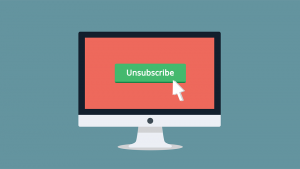
Everyone at one point has received an unsolicited email. Most of us know that cleaning them up from our inbox is as simple as clicking the unsubscribe button at the bottom of the page.
However, what most people don’t know is that clicking on those emails can get them into some serious trouble.
If a spammer sends you an email that looks legit, you may wind up giving away personal information about yourself when you decide to opt-out of his fake mailing list. Worst of all, you could grant him with the opportunity to send you some malware, though obviously not everyone who emails you is out to grab your personal data.
If you know the person or company who sent you the message, then you can simply unsubscribe. However, stay alert. Most phishing attacks rely on human interaction. In this day and age, it’s really easy to create a fake email, under a fake company name, and send from a fake place, all made to look like a real and reputable company that’s contacting you.
So keep your eyes out. You must develop the intuition to perceive when an email is meant to be unsubscribed from, and when it should be marked as spam.
In order to help you think twice about your actions, we have compiled 5 reasons why unsubscribing from an email can be a bad idea.
1. Your Email Has Been Marked as Valid and Active by Spammers
There is software that can detect if you have received and opened your email. If you received one, and have a normal, functional email account, then you have now fallen under the traps of a spammer. If your email works, chances are he’ll send it to his friends too.
2. If You Replied to an Email, You Have Just Told the Spammer That You Open and Read Them Too
Don’t worry. It happens. Some emails look real. Chances are, you weren’t even aware that it was spam. Sometimes, they come through your inbox looking so personal, you would say that your best friend wrote it. Unfortunately if you hit the reply button, you have now engaged in a two-way conversation with a spammer. To him, that’s wonderful news. Not only do you receive emails, but you reply to them too.
3. You Respond Via Email
Some spammers will ask you to reply with the word “unsubscribe”. By doing this, not only you are confirming that your email is active, but you’re giving him data about the email software you use.
That’s because emails contain something called meta information. This info can tell a spammer what kind of program you’re using. And based on the content of your email, he can imply specific things about your computer.
4. If You Open Up a New Browser Window, Then You Make Yourself Even More Vulnerable
When you go to a spammer’s site, he can figure out where you are, what operating system you’re using, and which browser you’re using.
He can also send you a cookie. So if you visit any of his other websites, he’ll be able to identify you.
5. The Scariest Thing of All
If you’re on a spammer’s website, he can install malware on your computer without you even realizing it.
These are cyber attacks called “drive-by downloads”. They can be tailored by the spammer to exploit you. This is possible thanks to the information you’ve shared.
So How Do You Avoid All of This?
Simply mark an unsolicited message you receive as spam.
When you mark it as spam, not only will your message be deleted, but you’ll “teach” your email service provider what spam looks like. So in the future, he’ll know what to do. He’ll look for and block all unwanted messages ahead of time.
A word to the wise, you should only unsubscribe from an email if you know who wrote it. Other than that, you might want to consider just marking it as spam.
